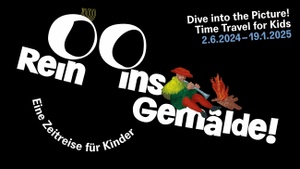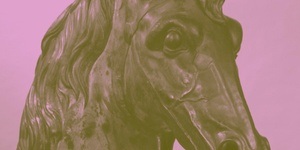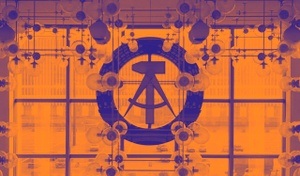Über Grenzen. Künstlerische Internationalismus in der DDR
In the organizer's words:
The temporary exhibition Über Grenzen (Across Borders) focuses on the international (cultural) political and artistic relations of the GDR with friendly socialist states and their after-effects in the present.
Complementary to the annual focus of the Humboldt Forum Hin und weg. The Palace of the Republic is Present , conceived by the curator for modern and contemporary art at the Museum of Asian Art and the Ethnological Museum of the National Museums in Berlin, the temporary exhibition Über Grenzen (Across Borders) opens up a differentiated spectrum in an interplay of artistic positions and archive materials:
It ranges from the GDR's official foreign cultural policy towards its friendly socialist states and liberation movements in Asia, Africa and the Americas to the (image) politics of intergraphics and the stories of migration and associated (post-)migrant cultures of remembrance and transformations after 1989.
Individual experiences and collective history are conveyed in the exhibition through artistic works and groups of works by Maithu Bùi, Seiichi Furuya, Mio Okido, Minh Duc Pham and Su-Ran Sichling.
Collages and drawings by the artist Mio Okido touch on questions of cultural memory and sometimes conflicting practices of remembrance in the GDR and FRG.
The works of photographer Seiichi Furuya deal with the collapse of individual and collective events. Arranged in a loose hanging, he shows city shots and interior views of East Berlin from 1985 to 1987.
Su-Ran Sichling'smaterial-conscious works are an examination of demarcation and permeability, social standardization and exclusion. Her series Gelehrtensteine (Scholars' Stones) is reminiscent of the East Asian tradition of naturally formed rocks as objects of contemplation, but was created from materials of East German post-war modernism.
Minh Duc Pham and Maithu Bùi also adopt the connotation of materials in their works to reflect associations and references to the immigration history of contract workers from Vietnam and the conditions of their residence status.
Cultural-political and international exchange relationships are presented in a documentary-archival module on intergraphics and can be researched there.
Intergrafik, the international graphic art exhibition, was first held in 1965 to mark the 20th anniversary of the end of the Second World War and was organized as a triennial by the Central Board of the Association of Visual Artists from 1967.
Exhibition focuses such as 1967, for example, artistic positions against the war in Vietnam and a focus on the work of Käthe Kollwitz or the participation of ANC/South Africa, Algeria, Bangladesh, Oman and Tanzania in 1973 underline the cultural-political orientation of Intergrafik.
A temporary exhibition of the Ethnologisches Museum and the Museum für Asiatische Kunst der Staatlichen Museen zu Berlin - Preußischer Kulturbesitz in cooperation with the Stiftung Humboldt Forum im Berliner Schloss and the artists Maithu Bùi, Seiichi Furuya, Mio Okido, Minh Duc Pham, Su-Ran Sichling.
PARTICIPANTS
- Mio Okido
- Su-Ran Sichling
- Minh Duc Pham
- Maithu Bùi
- Seiichi Furuya
- Gallery Thomas Fischer
FURTHER INFORMATION
- German, English
- 3RD FLOOR
- from 12 years
- free of charge
This content has been machine translated.













